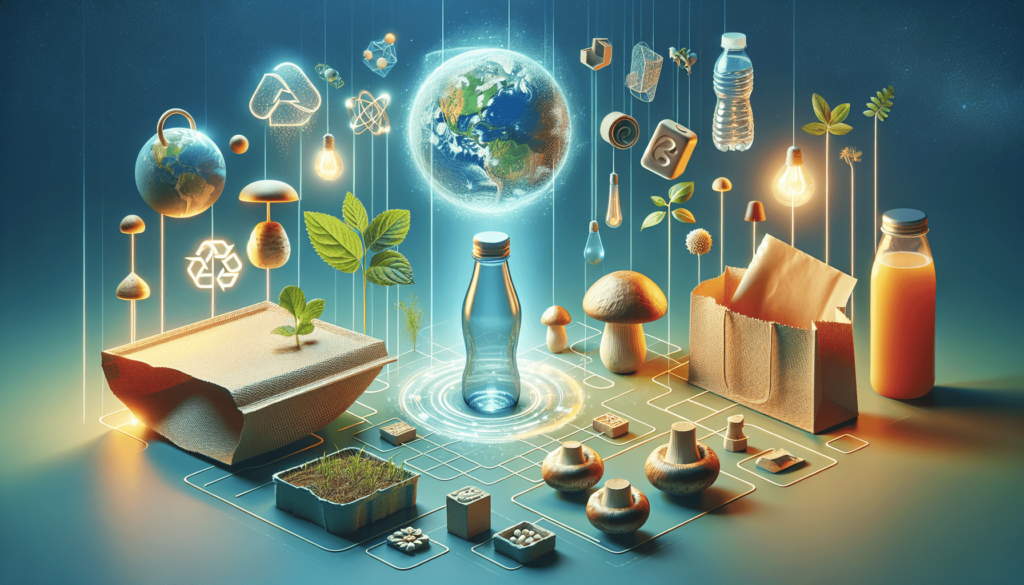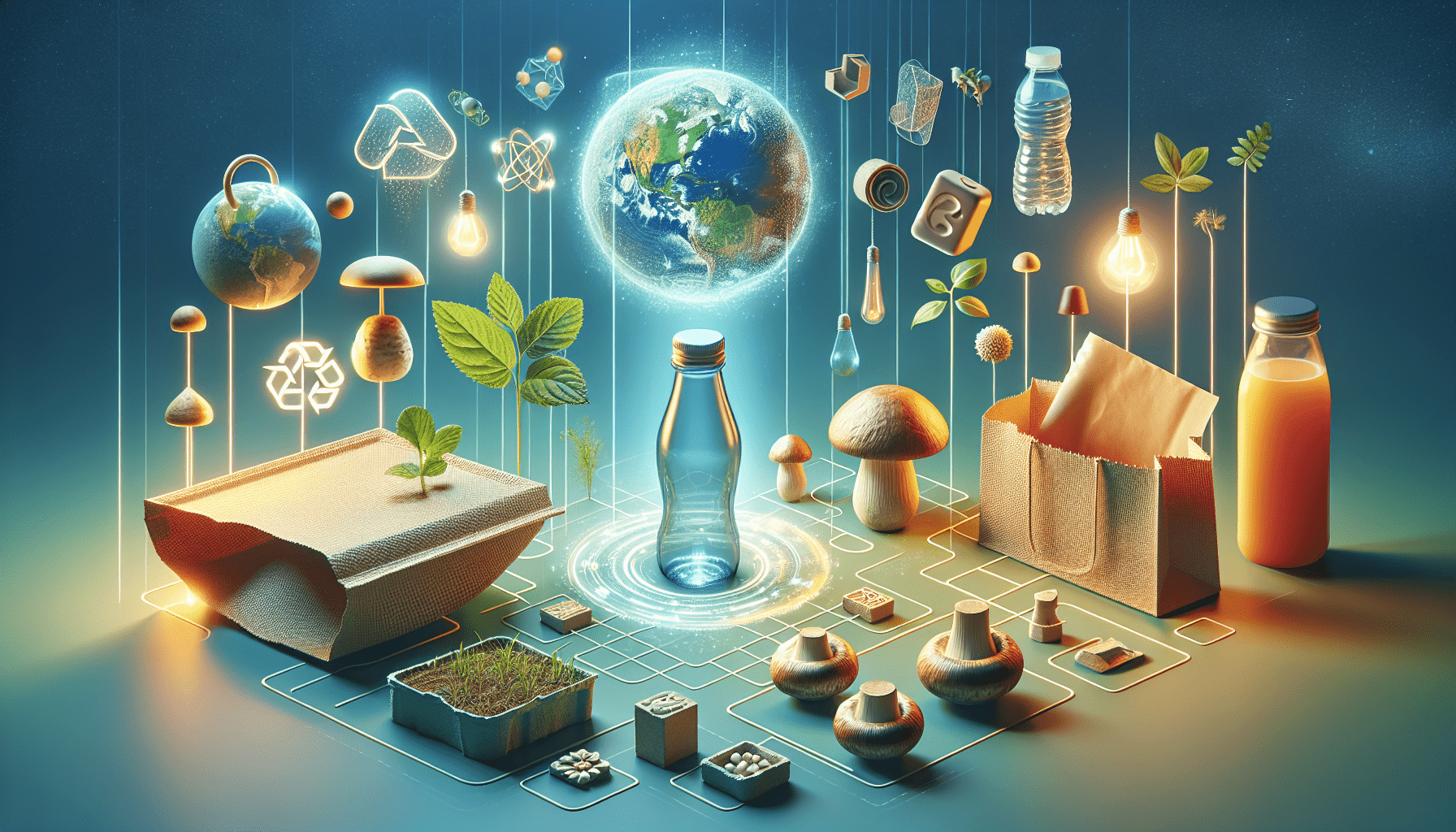Imagine a world where packaging materials are not only convenient and functional, but also sustainable for our planet. Well, that future might be closer than you think. With growing concerns about the environmental impact of traditional packaging, innovative alternatives are emerging on the market. From biodegradable plastics to compostable materials, this article explores the exciting developments in eco-friendly packaging materials and their potential to revolutionize the way we package our products. Get ready to discover a greener future for packaging!

Introduction to Eco-Friendly Packaging Materials
Eco-friendly packaging materials refer to those that are designed and produced with minimal impact on the environment. These materials are intended to address the increasing concerns about pollution, waste, and the depletion of natural resources caused by traditional packaging methods. By using eco-friendly packaging, businesses can make a positive contribution to sustainability while also meeting the demands of environmentally conscious consumers.
Definition
Eco-friendly packaging materials are sustainable alternatives to traditional packaging materials, such as plastics and Styrofoam, that are designed to minimize environmental impact. These materials are typically renewable, biodegradable, or recyclable, allowing them to be broken down by natural processes or repurposed for future use. By choosing eco-friendly packaging options, businesses can reduce their carbon footprint and contribute to a healthier planet.
Importance of Eco-Friendly Packaging
The importance of eco-friendly packaging cannot be overstated in today’s society. With growing concerns about climate change and environmental degradation, consumers are becoming increasingly aware of the need to reduce waste and curb pollution. By adopting eco-friendly packaging materials, businesses can meet consumer expectations, enhance their brand image, and differentiate themselves in the market. Moreover, eco-friendly packaging can help reduce the consumption of non-renewable resources, lower carbon emissions, and contribute to a more sustainable future.
Current Challenges and Concerns
While the benefits of eco-friendly packaging are evident, several challenges and concerns still need to be addressed in order to achieve widespread adoption and implementation.
Plastic Pollution
One of the biggest concerns in the packaging industry is plastic pollution. Traditional plastic packaging contributes to the growing problem of marine pollution, as discarded plastics end up in our oceans, posing a severe threat to marine life and ecosystems. Eco-friendly packaging alternatives aim to reduce reliance on plastic materials and provide sustainable options that can be easily recycled or biodegraded.
Limited Recycling Options
Another challenge is the limited availability of recycling options for certain eco-friendly packaging materials. For instance, while some materials like cardboard and paper are widely recyclable, others, such as bioplastics, require specialized recycling facilities. To overcome this challenge, it is crucial to invest in infrastructure and develop efficient recycling systems that can handle a diverse range of eco-friendly packaging materials.
High Production Costs
Another obstacle to widespread adoption of eco-friendly packaging materials is the high production costs associated with some alternatives. While traditional packaging materials like plastic are relatively inexpensive to produce, many eco-friendly options, such as biodegradable plastics or plant-based materials, come at a higher cost. However, advancements in technology and increased demand for eco-friendly packaging may help drive down production costs in the future.
Biodegradable Packaging Options
Biodegradable packaging options offer a sustainable alternative to traditional packaging materials by breaking down naturally over time.
Bioplastics
Bioplastics are a type of biodegradable plastic made from renewable sources such as corn, sugarcane, or vegetable oil. These materials can be manufactured to have similar properties to traditional plastics, making them suitable for various packaging applications. Bioplastics provide a viable solution to the plastic pollution problem as they can be composted, reducing the environmental impact associated with traditional plastics.
Mushroom Packaging
Mushroom packaging, also known as mycelium packaging, is a biodegradable alternative made from the root structure of mushrooms. This packaging material is grown by combining agricultural waste and mushroom spores, forming a sustainable packaging option that is completely compostable. Mushroom packaging can be molded into various shapes and sizes, making it versatile for different packaging needs.
Seaweed Packaging
Seaweed packaging is a promising eco-friendly option that uses seaweed as a raw material. Seaweed is a rapidly renewable resource that grows in abundance and requires minimal resources to cultivate. This packaging material is not only biodegradable but also has excellent barrier properties, which can help preserve the freshness of food products while reducing the need for additional synthetic packaging materials.

Renewable and Sustainable Materials
Renewable and sustainable packaging materials offer a greener alternative to traditional packaging options by utilizing renewable resources.
Plant-based Plastics
Plant-based plastics, also known as bio-based plastics, are derived from plant-based sources such as corn, sugarcane, or algae. These materials can be processed into a variety of packaging options, including bottles, bags, and containers. Plant-based plastics have the advantage of being renewable and reducing the consumption of fossil fuels compared to traditional plastics. They can also be recycled or composted, providing a truly sustainable packaging solution.
Recycled Paper and Cardboard
Recycled paper and cardboard are widely available and commonly used eco-friendly packaging materials. By using recycled fibers, these materials help reduce deforestation and minimize waste sent to landfills. Recycled paper and cardboard can be shaped and molded to fit different packaging needs, making them a versatile and sustainable option for businesses.
Cornstarch Packaging
Cornstarch packaging, also known as polylactic acid (PLA) packaging, is another renewable and compostable alternative to traditional plastic. It is made from fermented plant starch, such as corn or potato, and can be molded into different shapes. Cornstarch packaging offers a renewable and biodegradable solution that can be easily composted, reducing the impact on the environment.
Innovative Packaging Solutions
Innovation in packaging technology has given rise to exciting new solutions that go beyond traditional eco-friendly materials.
Edible Packaging
Edible packaging is a revolutionary solution that eliminates waste by allowing consumers to eat the packaging along with the product. This type of packaging is typically made from edible materials such as seaweed or food-grade gelatin. Edible packaging offers a unique and sustainable way to reduce waste and provide a memorable consumer experience.
Multi-functional Packaging
Multi-functional packaging refers to packaging that serves a dual purpose beyond its primary function. For example, packaging that can be repurposed as a storage container or transformed into a different product altogether. By promoting reusability and minimizing waste, multi-functional packaging contributes to a more sustainable packaging ecosystem.
Smart Packaging
Smart packaging utilizes integrated technology to provide additional functionality. This includes features such as temperature monitoring, freshness indicators, and interactive labels. By leveraging technology, smart packaging can reduce food waste, extend product shelf life, and enhance the overall consumer experience. This innovative packaging solution aligns sustainability with convenience and efficiency.
Advancements in Packaging Technology
Advancements in packaging technology play a crucial role in driving the development and adoption of eco-friendly packaging materials.
Nanotechnology
Nanotechnology has the potential to revolutionize the packaging industry by offering new ways to enhance the properties of packaging materials. By manipulating material properties at the nanoscale, packaging materials can be made stronger, more lightweight, and even self-healing. Nanotechnology can contribute to reducing packaging waste while improving overall performance.
3D Printing
3D printing, also known as additive manufacturing, has the potential to transform the way packaging is produced. By enabling on-demand production and customization, 3D printing reduces material waste and energy consumption compared to traditional manufacturing methods. This technology also allows for the creation of complex and unique packaging designs that can better meet the needs of individual products.
Intelligent Packaging
Intelligent packaging refers to packaging that incorporates sensors, RFID tags, and other technologies to provide real-time information about the product and its environment. This technology enables better product safety, traceability, and quality control. Intelligent packaging can also help reduce food waste by monitoring and communicating product freshness, allowing consumers to make informed decisions regarding product consumption.
Collaboration and Industry Initiatives
Collaboration and industry initiatives are essential in driving the adoption and implementation of eco-friendly packaging materials.
Government Regulations
Government regulations play a crucial role in creating a favorable environment for eco-friendly packaging adoption. By implementing policies that promote sustainable packaging practices, governments can incentivize businesses to adopt environmentally friendly alternatives and hold them accountable for their impact on the environment. Regulatory frameworks can drive innovation and provide a level playing field for businesses to transition to more sustainable packaging materials.
Partnerships and Alliances
Partnerships and alliances between businesses, manufacturers, and non-profit organizations are instrumental in driving sustainable packaging initiatives. Collaborative efforts can lead to the development of innovative solutions, shared knowledge, and the pooling of resources to implement sustainable packaging practices. By working together, stakeholders can accelerate the adoption and implementation of eco-friendly packaging across industries.
Consumer Awareness Campaigns
Increasing consumer awareness about the importance of eco-friendly packaging is crucial to drive demand for sustainable products. Consumer awareness campaigns can educate the public about the environmental impact of traditional packaging materials and highlight the benefits of eco-friendly alternatives. By empowering consumers to make informed choices, these campaigns can create a demand-pull effect, driving businesses to adopt sustainable packaging practices to meet consumer preferences.
Adoption and Implementation Challenges
While the benefits of eco-friendly packaging are evident, there are several challenges that need to be addressed to facilitate widespread adoption.
Infrastructure and Manufacturing Capability
One major challenge is the lack of adequate infrastructure and manufacturing capability for eco-friendly packaging materials. Specialized recycling facilities, composting facilities, and processing plants are necessary to handle and convert eco-friendly materials. Investments in infrastructure are required to support the collection, processing, and end-of-life management of these materials on a large scale.
Consumer Acceptance and Behavior
Shifting consumer behavior and acceptance of eco-friendly packaging can be a challenge. Consumers are accustomed to traditional packaging materials and may be resistant to change. Raising awareness, educating consumers about the benefits, and providing clear information about the disposal and recycling of eco-friendly packaging can help accelerate consumer acceptance.
Cost-effectiveness
The cost-effectiveness of eco-friendly packaging materials can be a barrier to adoption. Many sustainable alternatives are currently more expensive to produce than traditional materials. However, as demand for eco-friendly packaging increases and technology advances, economies of scale can reduce production costs and make eco-friendly options more affordable for businesses. Additionally, implementing extended producer responsibility programs and other financial incentives can help overcome cost-related challenges.
Case Studies and Success Stories
Numerous companies and brands have embraced eco-friendly packaging, leading the way and setting positive examples for the industry.
Companies and Brands Leading the Change
Patagonia, a well-known outdoor apparel brand, has been at the forefront of eco-friendly packaging. They utilize recycled and recyclable materials for their product packaging, reducing waste and conserving resources. Patagonia’s commitment to sustainable packaging aligns with their overall mission to reduce their ecological footprint.
Loop, an innovative reusable packaging platform, partners with various brands, including major corporations like Procter & Gamble and Unilever, to eliminate single-use packaging. Loop provides refillable packaging options, enabling consumers to return empty containers and reduce waste. This collaborative approach illustrates how businesses can work together to implement sustainable packaging solutions.
Positive Environmental Impact
The adoption of eco-friendly packaging materials has resulted in significant environmental benefits. For example, companies using plant-based plastics have reduced their reliance on fossil fuel-based materials and lowered carbon emissions. The use of recycled paper and cardboard has contributed to reducing deforestation and preserving natural resources. By making the switch to eco-friendly packaging, businesses can actively contribute to positive environmental change.
Future Outlook for Eco-Friendly Packaging
The future of eco-friendly packaging looks promising, with several emerging trends and ongoing research and development efforts.
Emerging Trends
Emerging trends in eco-friendly packaging include the use of biodegradable nanomaterials, such as cellulose nanocrystals, which offer enhanced mechanical and barrier properties. The development of bio-based coatings and films to improve the functionality and shelf life of eco-friendly packaging is also gaining traction. Additionally, the integration of sustainable packaging into the circular economy concept is expected to drive innovation and strengthen the adoption of eco-friendly materials.
Research and Development
Research and development efforts are focused on improving the performance, versatility, and cost-effectiveness of eco-friendly packaging materials. Scientists and engineers are exploring new biomaterials, such as algae-based polymers and lignin-based composites, that have the potential to revolutionize the packaging industry. Additionally, researchers are studying ways to optimize recycling processes and develop more efficient composting techniques for eco-friendly packaging materials.
Global Market Potential
The global market potential for eco-friendly packaging is significant and continues to expand. With increasing consumer awareness and demand, businesses have a unique opportunity to capitalize on the growing market share of sustainable packaging. As more countries implement regulations and initiatives to promote the use of eco-friendly packaging, the market for these materials will continue to grow, creating opportunities for companies to develop innovative solutions and gain a competitive edge.
In conclusion, eco-friendly packaging materials offer a sustainable solution to the packaging industry’s growing challenges. By embracing these materials, businesses can contribute to a healthier, greener future while meeting the demands of environmentally conscious consumers. While there are challenges to overcome, such as plastic pollution and high production costs, advancements in technology, collaboration, and consumer awareness campaigns are paving the way for a brighter future for eco-friendly packaging. With continued research and development, emerging trends, and a global market potential, the adoption of eco-friendly packaging is set to become the norm, promoting a more sustainable and environmentally responsible packaging industry.

